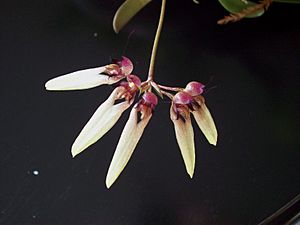Pale umbrella orchid facts for kids
Quick facts for kids Pale umbrella orchid |
|
|---|---|
 |
|
| Conservation status | |
| Scientific classification | |
| Genus: |
Bulbophyllum
|
| Species: |
longiflorum
|
The pale umbrella orchid (Bulbophyllum longiflorum) is a special type of orchid that grows on other plants or rocks. It's found in many places, including parts of Africa, islands in the Indian Ocean and Pacific Ocean, Southeast Asia, New Guinea, and northern Australia.
This orchid has a stem that creeps along, with dark green, swollen parts called pseudobulbs. Each pseudobulb has one large, thick leaf. Its flowers grow in a half-circle shape, like one side of an umbrella. They are canoe-shaped and are usually greenish-cream or yellowish with purple dots.
Contents
What the Pale Umbrella Orchid Looks Like
The pale umbrella orchid is a herbaceous plant that grows on other plants or rocks. It has a stem that creeps along the ground or surface. This stem has dark green, grooved pseudobulbs, which are like swollen stems. They are about 30 to 45 mm (1.2 to 1.8 inches) long and 15 to 20 mm (0.6 to 0.8 inches) wide.
Each pseudobulb has one thick, dark green leaf at its end. These leaves are about 80 to 150 mm (3.1 to 5.9 inches) long and 20 to 30 mm (0.8 to 1.2 inches) wide.
Its Unique Flowers
The orchid produces between five and eight flowers. They are arranged in a spreading, half-circle shape, like an umbrella, and the whole flower cluster is about 100 to 200 mm (3.9 to 7.9 inches) long. Each flower sits on a small stalk about 15 to 20 mm (0.6 to 0.8 inches) long.
The flowers are greenish-cream to yellowish, with purple spots or dots. They are about 30 to 40 mm (1.2 to 1.6 inches) long and 3 to 5 mm (0.1 to 0.2 inches) wide.
- The top sepal (a part of the flower that looks like a petal) is egg-shaped. It's about 6 to 8 mm (0.2 to 0.3 inches) long and 4 to 5 mm (0.1 to 0.2 inches) wide. It forms a hood over the center part of the flower. It also has a long, hair-like tip.
- The side sepals are about 25 to 35 mm (1.0 to 1.4 inches) long and 3 to 5 mm (0.1 to 0.2 inches) wide. They are joined together along their sides.
- The petals are triangular and curved. They are about 6 to 18 mm (0.2 to 0.7 inches) long and 4 to 5 mm (0.1 to 0.2 inches) wide.
- The labellum (the orchid's special lip petal) is dark purple, thick, and curved. It's about 4 to 5 mm (0.1 to 0.2 inches) long and about 2 mm (0.08 inches) wide, with a groove down the middle.
When it Flowers
In Australia, this orchid usually flowers between January and March. In Africa, it flowers from October to January. In New Guinea, you can see it flowering throughout the whole year.
How it Got its Name
The pale umbrella orchid, Bulbophyllum longiflorum, was first officially described in 1822. It was named by a botanist named Louis-Marie Aubert du Petit-Thouars. He wrote about it in his book called Histoire particulière des plantes orchidées recueillies sur les trois Iles Australes d’Afrique, de France, de Bourbon et de Madagascar.
Where the Pale Umbrella Orchid Lives
The pale umbrella orchid is found in many different places around the world. You can find it in Africa, Madagascar, the Mascarene Islands, and the Seychelles. It also grows further east in Malaysia, New Guinea, New Caledonia, Fiji, and the Society Islands and Austral Islands.
In Australia, it lives in Queensland, specifically in the Iron and McIlwraith Ranges. It likes to grow in rainforests and hill forests. You can find it from sea level all the way up to about 1,700 meters (5,600 feet) high.
Protecting the Pale Umbrella Orchid
This beautiful orchid is considered "vulnerable" by the Australian Government. This means it's at risk of becoming endangered if we don't protect it. The biggest problem for the pale umbrella orchid is that some people illegally collect it. They take it from its natural home, which harms the wild populations.
See also
 In Spanish: Bulbophyllum longiflorum para niños
In Spanish: Bulbophyllum longiflorum para niños


